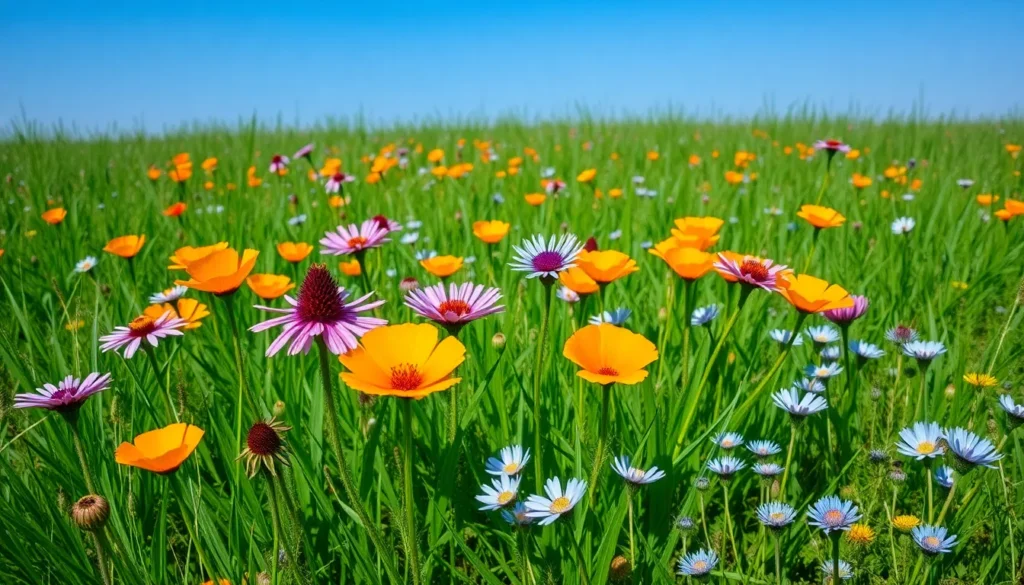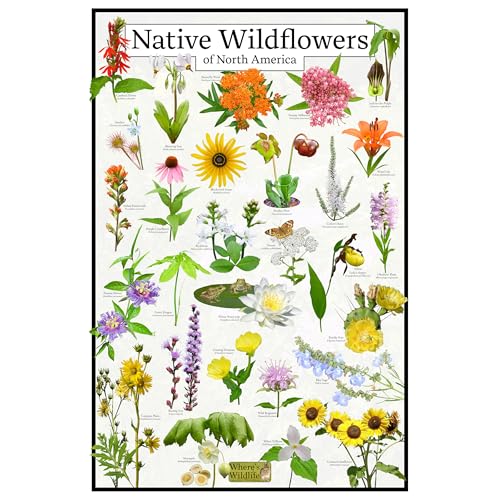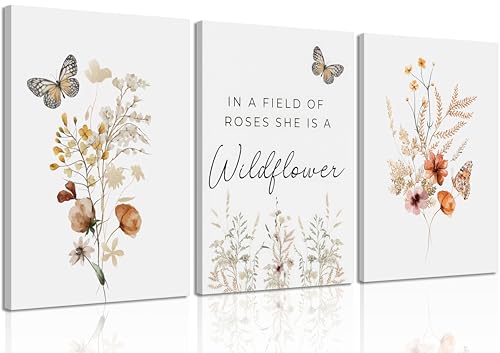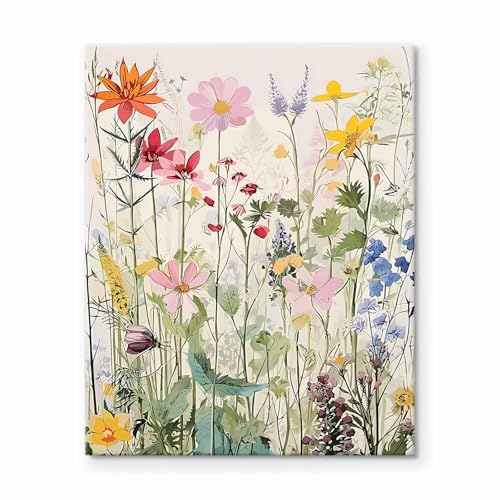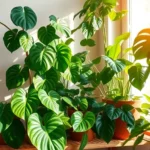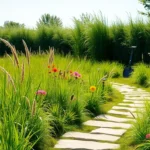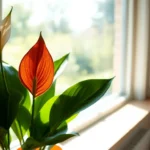Wildflowers transform our landscapes into breathtaking natural canvases, painting meadows and roadsides with vibrant colors that captivate our senses. These resilient beauties grow without human intervention, adapting to diverse environments from mountain slopes to desert plains. We’ve all experienced that moment of wonder when stumbling upon a field of colorful blooms during a nature walk.
Understanding the different types of wildflowers helps us appreciate the incredible diversity nature offers. From delicate spring ephemerals that bloom for just weeks to hardy perennials that return year after year, each species brings its own unique charm and ecological benefits. Some attract butterflies and bees while others provide food for birds and small mammals.
Whether you’re a gardening enthusiast looking to create a natural industry or simply curious about the flowers you encounter outdoors, we’ll explore the intriguing area of wildflowers. Let’s discover the characteristics that make each type special and learn how to identify them in their natural habitats.
Annual Wildflowers That Bloom for One Season
Annual wildflowers complete their entire life cycle within a single growing season, creating spectacular displays that return each year through self-seeding. These remarkable plants germinate from seed, bloom profusely, set seed, and die all within one year.
California Poppies
Eschscholzia californica transforms landscapes with vibrant orange blooms that open during sunny days and close at night. We’ll find these drought-tolerant wildflowers thriving in sandy soils across western regions, where they create stunning carpets of color from February through September. California poppies self-seed readily and can handle poor soil conditions that challenge other annuals.
Growing 6 to 12 inches tall, these resilient flowers feature feathery blue-green foliage that complements their silky petals. Native Americans traditionally used California poppies for medicinal purposes, and today we recognize them as California’s official state flower.
Cornflowers
Centaurea cyanus produces striking blue flowers that earned the nickname “bachelor’s button” due to unmarried men wearing them as boutonnieres. We encounter these European natives in fields, roadsides, and wildflower meadows where they bloom from late spring through early fall. Cornflowers prefer full sun and well-draining soil but adapt to various growing conditions.
Standing 12 to 36 inches tall, cornflowers develop sturdy stems topped with distinctive fringed petals in shades of blue, pink, white, or purple. These versatile annuals attract butterflies and bees while serving as excellent cut flowers that maintain their color when dried.
Cosmos
Cosmos bipinnatus creates airy displays of daisy-like flowers in pink, white, and magenta that dance gracefully in summer breezes. We appreciate these Mexican natives for their ability to thrive in poor soils and drought conditions while producing continuous blooms from midsummer until frost. Cosmos self-seed generously, ensuring natural wildflower populations return year after year.
Reaching heights of 2 to 6 feet, cosmos develop delicate feathery foliage that provides an elegant backdrop for their cheerful flowers. These low-maintenance annuals attract beneficial insects including butterflies, bees, and birds that feed on their abundant seeds.
Perennial Wildflowers That Return Year After Year
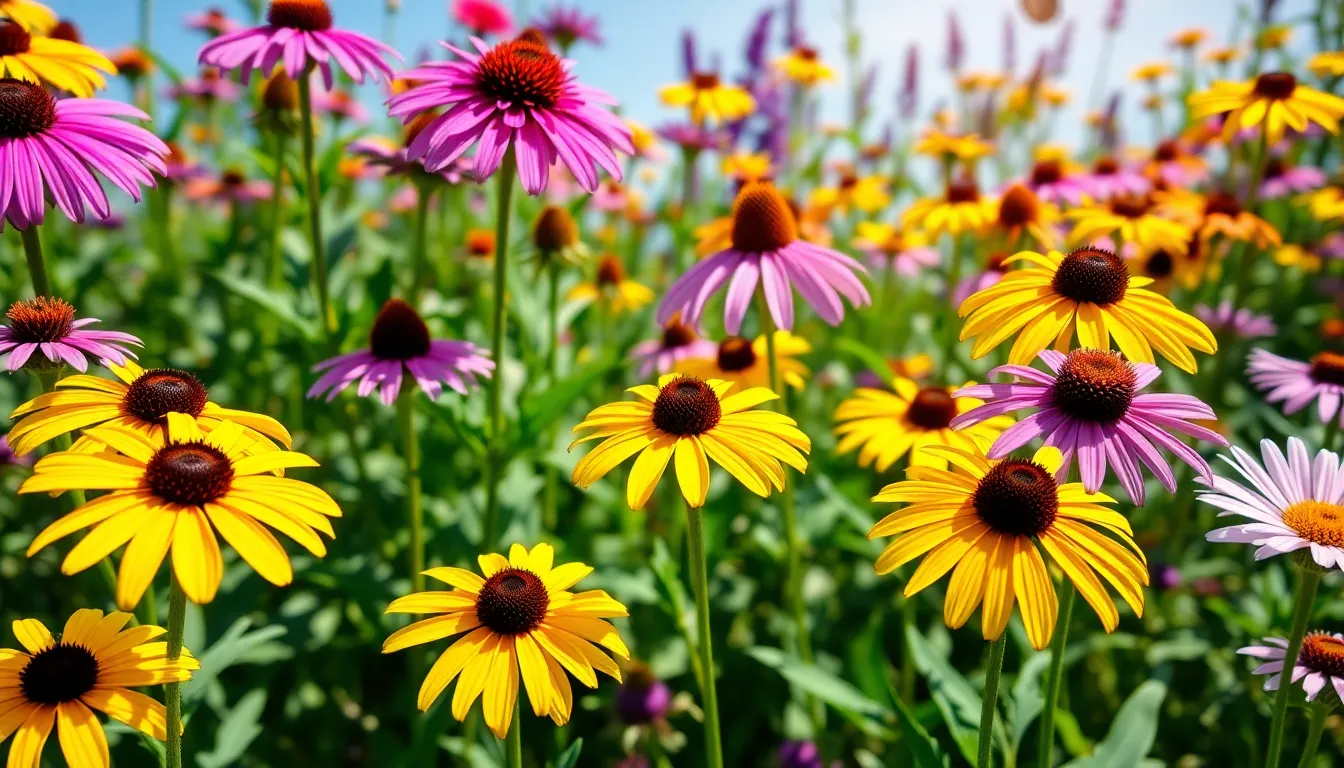
Unlike their annual counterparts, perennial wildflowers establish lasting root systems that allow them to bloom reliably for multiple seasons. These hardy plants form the backbone of sustainable wildflower gardens and natural prairies across North America.
Black-Eyed Susans
Black-Eyed Susans stand out with their vibrant yellow petals radiating from distinctive dark centers. We find these cheerful blooms throughout many regions of North America, where they create stunning golden displays from midsummer through early fall.
Gardeners appreciate how these resilient flowers spread naturally through underground rhizomes and self-seeding. Birds like goldfinches feast on their seed heads during winter months, making them valuable additions to wildlife-friendly landscapes. Their drought tolerance means they’ll thrive even during dry spells once established.
Purple Coneflowers
Purple Coneflowers command attention with their large, showy purple petals that surround prominent cone-shaped centers. We recognize these striking blooms as prairie favorites that attract many pollinators including bees, butterflies, and beneficial insects.
These robust perennials develop deep taproots that help them survive harsh weather conditions. Their sturdy stems reach heights of 2-4 feet, creating impressive vertical interest in wildflower meadows. Native American tribes traditionally used various parts of these plants for medicinal purposes, highlighting their cultural significance beyond ornamental value.
Wild Bergamot
Wild Bergamot produces clusters of tubular flowers in shades of red, pink, or purple that butterflies and hummingbirds find irresistible. We also know this aromatic plant as Bee Balm due to its popularity among pollinating insects.
This fragrant perennial releases a distinctive minty scent when its leaves are crushed or brushed against. Colonies spread through underground runners, forming dense patches that provide excellent ground coverage. Their square stems and opposite leaves identify them as members of the mint family, while their extended blooming period offers nectar sources throughout the growing season.
Native Prairie Wildflowers of North America
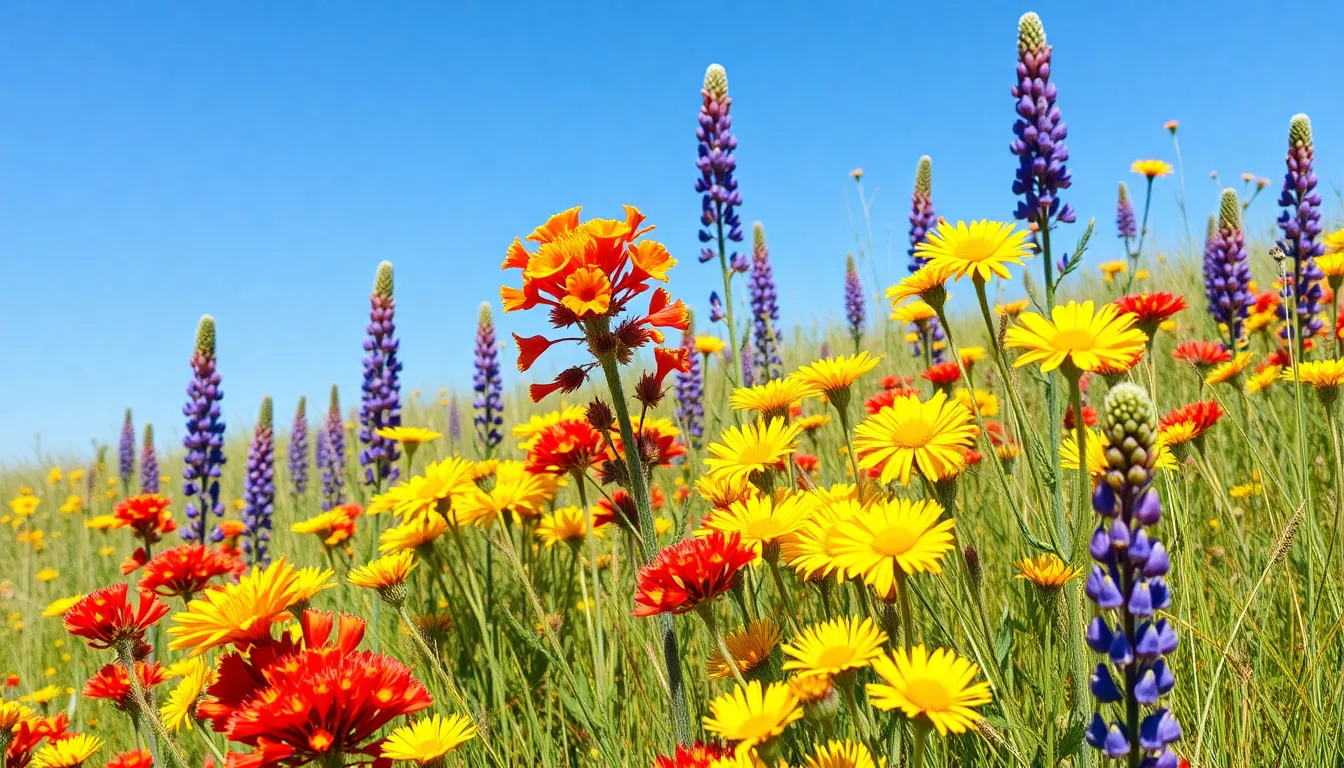
Building on our exploration of perennial varieties, we now discover the spectacular native prairie species that have adapted to North America’s grassland ecosystems. These resilient wildflowers showcase remarkable diversity while supporting crucial ecological relationships across the continent.
Indian Paintbrush
Indian Paintbrush creates stunning displays with its distinctive red and yellow flowers that appear to be dipped in vibrant paint. We find this remarkable wildflower, scientifically known as Castilleja coccinea, thriving in prairies and open woodlands throughout North America.
Nature designed these flowers with a unique structure where colorful bracts surround the actual blooms, creating the paintbrush effect that gives this species its common name. Wildlife benefits tremendously from Indian Paintbrush as hummingbirds frequently visit for nectar while butterflies use the plants for feeding stations.
Gardeners appreciate how Indian Paintbrush establishes itself in poor soils where other flowers struggle to grow. Conservation efforts often include this species in prairie restoration projects because it helps stabilize soil and provides essential habitat for native pollinators.
Blanket Flowers
Blanket Flowers produce large, daisy-like blooms that combine stunning shades of yellow, orange, and red in patterns reminiscent of Native American blankets. We recognize Gaillardia x grandiflora by its bold colors and exceptional drought tolerance that makes it perfect for challenging growing conditions.
Blooming season extends from early summer through fall, providing continuous color when many other wildflowers fade. Pollinators flock to these flowers throughout the growing season, with bees and butterflies particularly drawn to their abundant nectar sources.
Maintenance requirements remain minimal as Blanket Flowers self-seed readily and adapt to various soil conditions. Industry designers frequently incorporate these hardy perennials into xeriscaping projects and naturalized areas where low-maintenance beauty is essential.
Wild Lupine
Wild Lupine develops impressive spikes of colorful flowers in shades of pink, purple, and white that create vertical interest in prairie landscapes. We identify this perennial species, Lupinus perennis, by its distinctive palmate leaves and tower-like flower clusters that can reach up to three feet tall.
Ecological importance of Wild Lupine extends far beyond its visual appeal, as it serves as the sole host plant for the endangered Karner Blue butterfly. Nitrogen-fixing abilities allow this legume to improve soil quality for surrounding plants while its deep taproot helps prevent erosion.
Growing conditions favor well-drained, sandy soils where Wild Lupine establishes robust colonies over time. Wildlife enthusiasts value this species for its role in supporting rare butterfly populations and its ability to attract diverse pollinators throughout the blooming period.
Woodland Wildflowers That Thrive in Shade
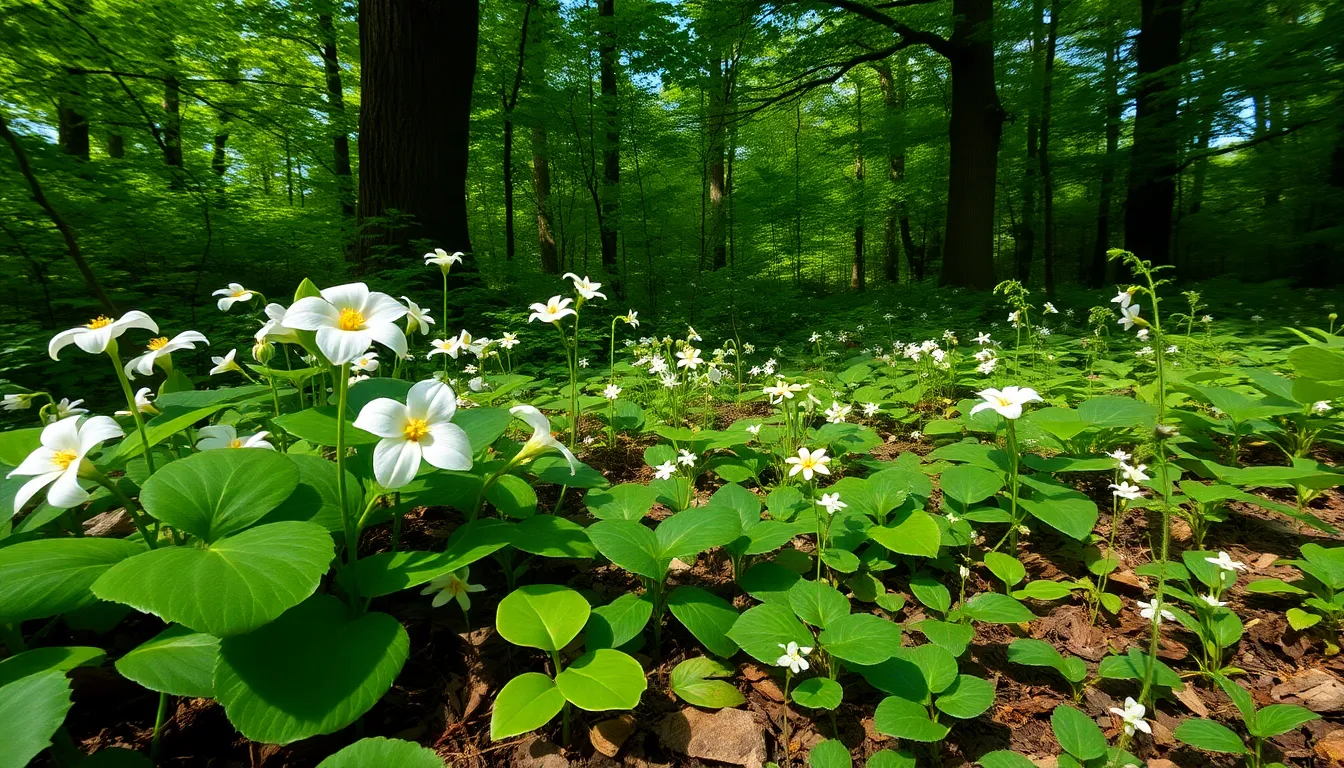
While prairie wildflowers dominate open grasslands, shaded woodland environments host their own spectacular collection of native blooms. These shade loving wildflowers create enchanting displays beneath forest canopies where direct sunlight rarely penetrates.
Trilliums
Trilliums stand among the most recognizable woodland wildflowers, producing distinctive three petaled blooms in white, yellow, or purple. These perennial plants emerge in early spring before trees fully leaf out, taking advantage of filtered sunlight that reaches the forest floor. We find them thriving in well drained, moist soils with rich organic matter from decomposing leaves.
Their unique flower structure features three petals, three sepals, and three leaves arranged in perfect symmetry. Gardeners appreciate trilliums for their reliability in partial to full shade conditions, where they naturalize over time to form impressive colonies. Native throughout much of North America, these woodland gems require patience as they take several years to mature from seed to flowering size.
Wild Ginger
Wild Ginger creates dense groundcover carpets in shaded woodland areas with its distinctive heart shaped leaves. This North American native produces small, hidden flowers near ground level that often go unnoticed beneath the foliage canopy. We recommend wild ginger for gardeners seeking low maintenance shade plants that spread naturally through underground rhizomes.
The plant’s aromatic roots give it its common name, though it’s unrelated to culinary ginger species. Wild ginger thrives in moist, well drained soils and tolerates full shade better than most wildflowers. Its ability to suppress weeds while providing attractive foliage makes it valuable for naturalizing difficult shaded slopes and woodland borders.
Bloodroot
Bloodroot produces pristine white flowers that emerge directly from the soil in early spring, often before its distinctive lobed leaves fully unfurl. This native wildflower gets its name from the bright red orange sap that flows from cut roots and stems. We observe bloodroot thriving in partial to full shade with consistently moist, well drained woodland soils.
Each flower typically lasts only a few days, but the timing creates spectacular early season displays when few other plants are blooming. The plant’s ephemeral nature means it goes dormant by midsummer after storing energy in its underground rhizomes. Bloodroot serves as an important early nectar source for native pollinators emerging from winter dormancy, supporting woodland network health throughout the growing season.
Desert Wildflowers Adapted to Arid Conditions
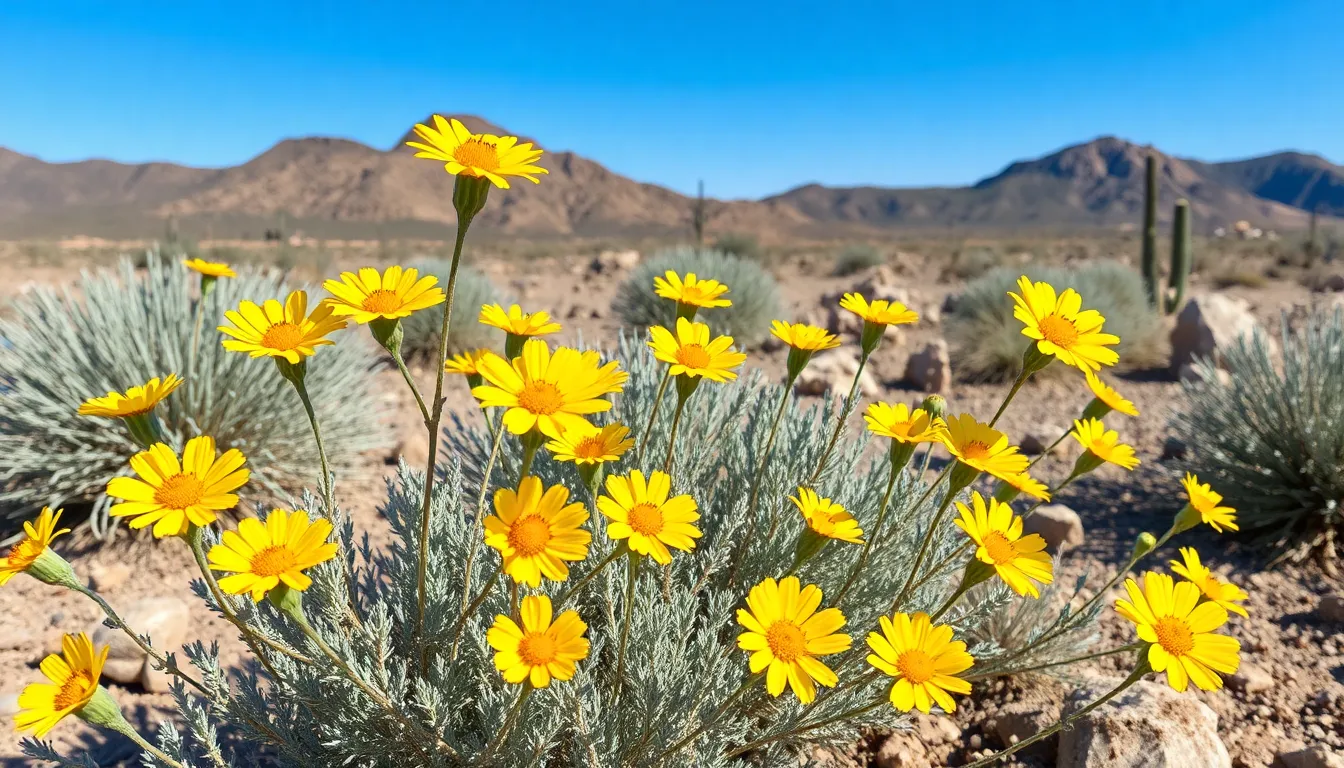
Desert environments challenge most plants with extreme heat and minimal water, yet certain wildflowers have evolved remarkable adaptations to thrive in these harsh conditions.
Desert Marigold
Baileya multiradiata transforms arid landscapes with its brilliant yellow blooms that can withstand the most challenging desert conditions. We often spot these resilient flowers throughout the southwestern United States, where they’ve mastered the art of desert survival.
Desert Marigold displays papery petals that protect the flower’s center from intense solar radiation while conserving precious moisture. The plant’s silvery green foliage reflects heat effectively, allowing it to maintain cooler temperatures during scorching summer days.
These hardy wildflowers bloom repeatedly throughout the growing season, providing consistent color in environments where most plants struggle to survive. Their deep taproot system reaches far underground to access water sources that shallow rooted plants can’t reach.
Ghost Plant
Graptopetalum paraguayense creates ethereal beauty in desert gardens with its distinctive succulent characteristics and delicate white flowers. We recognize this unique wildflower by its thick, fleshy leaves that store water for extended drought periods.
The plant’s pale blue green coloration gives it a ghostly appearance that inspired its common name. Its leaves form tight rosettes that minimize surface area exposed to harsh desert winds and intense sunlight.
Ghost Plant produces small white flowers on tall stalks that emerge from the center of each rosette during favorable conditions. These blooms attract desert pollinators like bees and butterflies, creating vital connections in arid ecosystems.
Prickly Pear Cactus Flowers
Opuntia species produce some of the most spectacular blooms in desert environments, displaying vibrant yellow, red, and pink flowers that contrast dramatically with their spiny pads. We find these remarkable flowers emerging from the edges of flat, paddle shaped cactus segments during spring and early summer.
Each flower typically measures 2 to 4 inches across and features many delicate petals surrounding a center filled with bright yellow stamens. The blooms attract specialized desert pollinators including native bees, beetles, and birds that have adapted to navigate around the plant’s protective spines.
Prickly Pear flowers transform into colorful fruits called tunas that provide food for desert wildlife and have been used by indigenous peoples for centuries. These fruits range from deep purple to bright red, adding another layer of visual interest to already stunning desert landscapes.
Wetland Wildflowers Found Near Water Sources
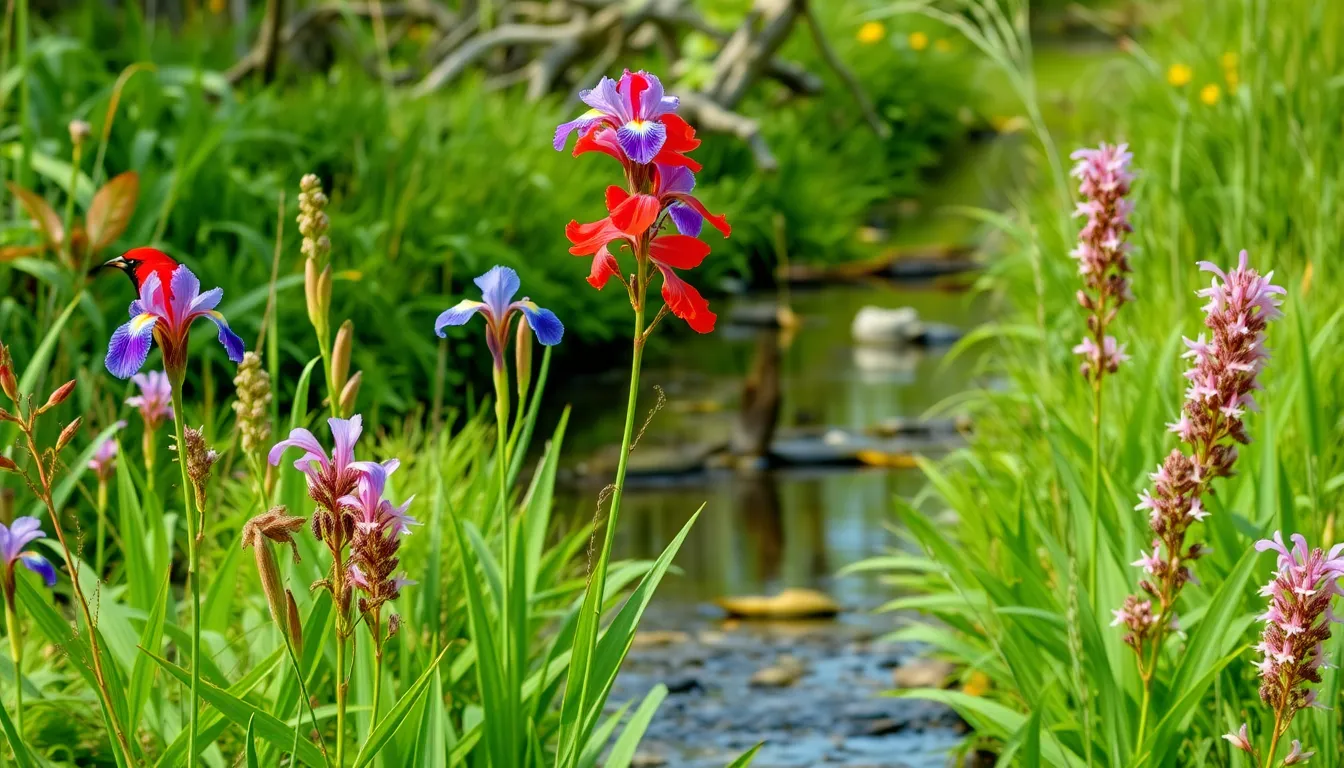
Wetland environments support some of the most vibrant and ecologically important wildflowers we encounter in nature. These moisture loving plants thrive in areas where water meets land, creating stunning displays along streams, marshes, and pond edges.
Cardinal Flower
Cardinal Flower stands out as one of the most striking wetland wildflowers we can find near water sources. This magnificent plant produces vibrant red flowers that create spectacular displays along streams and wetlands throughout North America. Hummingbirds find Cardinal Flower particularly attractive, making it an essential component of wetland ecosystems. We often spot these brilliant blooms from July through September, when their intense scarlet color contrasts beautifully against green foliage. Growing typically 2 to 4 feet tall, Cardinal Flower prefers consistently moist soil and partial shade conditions. Its scientific name Lobelia cardinalis reflects the plant’s resemblance to the red robes worn by Catholic cardinals.
Blue Flag Iris
Blue Flag Iris creates elegant displays in wetland areas with its distinctive blue flowers and sword like leaves. We recognize this native North American wildflower by its three petaled blooms that feature intricate purple veining and yellow markings. Wetlands throughout the continent provide the perfect habitat for Blue Flag Iris, which blooms from late spring through early summer. These resilient plants can tolerate both standing water and seasonal flooding, making them ideal for rain gardens and natural water features. Iris versicolor typically reaches heights of 2 to 3 feet and forms dense colonies that help prevent soil erosion along water edges. Native Americans traditionally used various parts of this plant for medicinal purposes and basket weaving.
Swamp Milkweed
Swamp Milkweed serves as a crucial habitat for monarch butterflies while thriving in wet environments across North America. This essential wildflower produces clusters of pink to mauve flowers that bloom from June through August, attracting many pollinators to wetland areas. We value Swamp Milkweed not only for its beauty but also for its role in supporting monarch butterfly populations during their epic migrations. Unlike its prairie dwelling relatives, this milkweed species prefers consistently moist soil and can tolerate seasonal flooding. Growing 3 to 4 feet tall, Swamp Milkweed develops deep root systems that help stabilize soil in wetland environments. Asclepias incarnata produces distinctive seed pods that split open to release seeds with silky white hairs, ensuring the plant’s continued presence in suitable wetland habitats.
Mountain Wildflowers That Grow at High Elevations
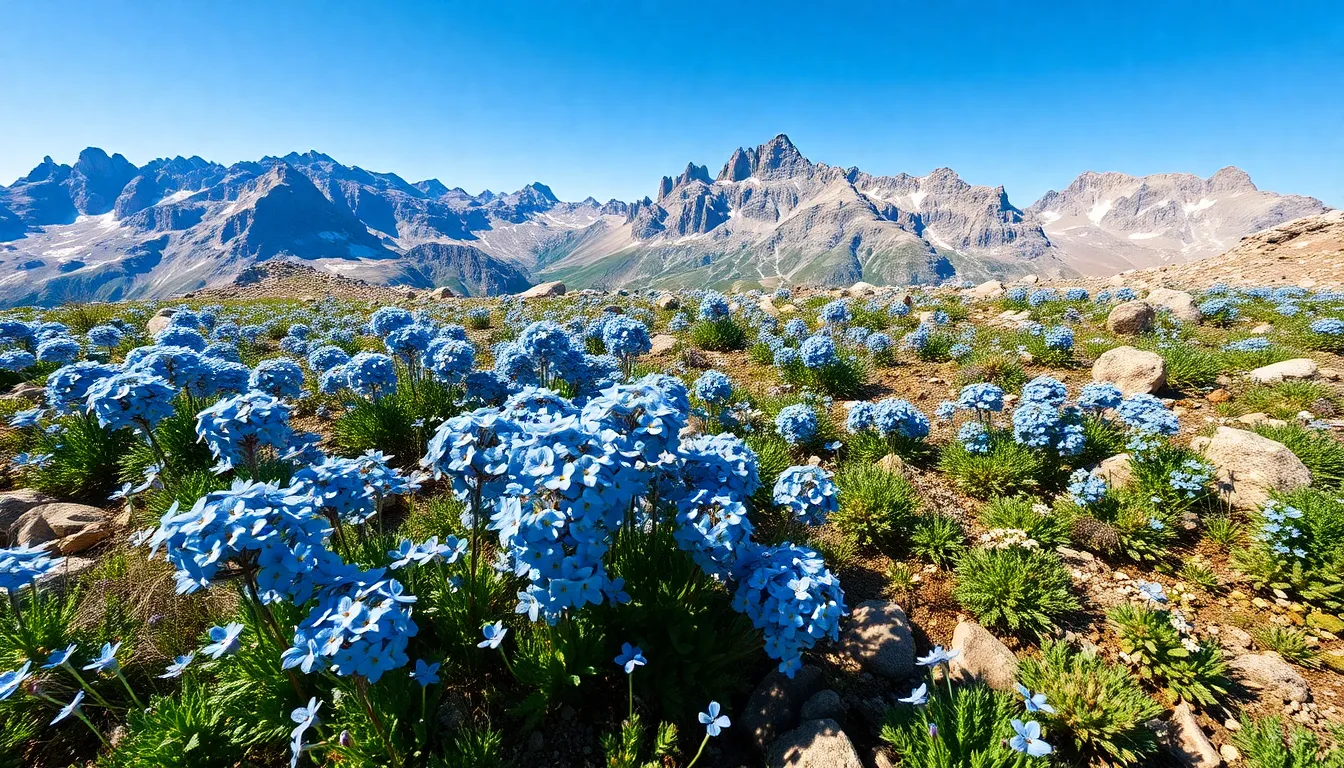
Mountain wildflowers showcase remarkable adaptations to extreme conditions, thriving where few other plants can survive. These resilient species create stunning displays against rocky backdrops and demonstrate nature’s incredible ability to flourish at high altitudes.
Alpine Forget-Me-Nots
Alpine Forget-Me-Nots produce delicate blue flowers that create breathtaking carpets across high-altitude rocky terrain. These small wildflowers have evolved specialized root systems that anchor them securely in thin mountain soils and withstand fierce winds. We find these hardy perennials blooming from late spring through early summer, typically between 8,000 and 12,000 feet elevation.
Their compact growth habit rarely exceeds 6 inches in height, allowing them to conserve energy in harsh alpine conditions. Mountain climbers and hikers often encounter these charming blue blooms nestled between granite boulders and along scree slopes. The flowers’ intense blue color serves as a beacon for high-altitude pollinators like alpine bees and butterflies.
Mountain Avens
Mountain Avens display elegant white or pink flowers that stand out dramatically against alpine meadows and rocky outcrops. These robust wildflowers belong to the rose family and develop deep taproots that can extend several feet into rocky soil to access moisture. We observe their blooming period lasting from June through August, depending on snowmelt patterns and elevation.
Their distinctive eight-petaled flowers create stunning displays across subalpine and alpine zones, often forming dense colonies. Mountain Avens adapt to extreme temperature fluctuations by growing in low, cushion-like mats that conserve heat. The flowers attract specialized mountain pollinators while providing nectar sources in environments where few other plants bloom.
Fireweed
Fireweed produces tall spikes of pinkish-purple flowers that create dramatic vertical displays in mountain landscapes. This remarkable wildflower thrives in areas with recent burns, earning its name by being among the first plants to colonize fire-damaged terrain. We observe Fireweed growing at elevations up to 9,000 feet, where it can reach heights of 3 to 8 feet.
Their rapid colonization abilities make them essential for network recovery after wildfires or other disturbances. Fireweed blooms progress from bottom to top along each spike, providing extended nectar sources for mountain wildlife including bears, who consume the young shoots. The flowers eventually transform into fluffy white seeds that disperse on mountain winds, establishing new colonies across vast alpine territories.
Coastal Wildflowers That Tolerate Salt Spray
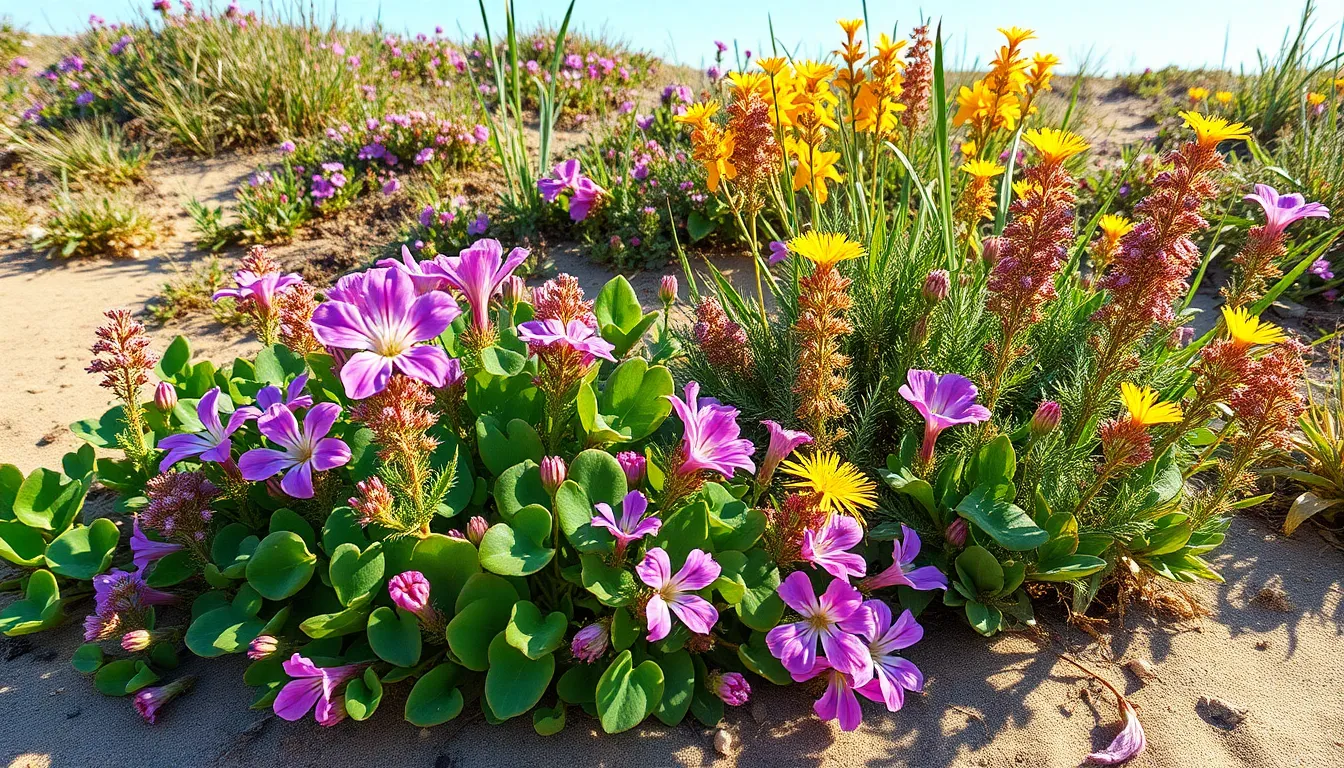
Coastal environments present unique challenges for wildflowers with salt spray, sandy soils, and strong winds creating harsh growing conditions. These resilient species have evolved specialized adaptations that allow them to thrive where most plants struggle.
Sea Thrift
Sea Thrift creates stunning displays of vibrant pink flowers along coastal regions where salt spray would kill most other plants. This hardy perennial forms dense cushions of grass-like foliage that can withstand constant exposure to ocean winds and salt. We find this wildflower thriving in rocky cliffs, sandy dunes, and coastal meadows throughout North America’s shorelines.
Drainage becomes crucial for Sea Thrift’s success as it requires well-draining soils to prevent root rot in coastal environments. The plant’s compact growth habit helps it conserve moisture while its waxy leaves reduce water loss from salt spray damage. Gardeners can successfully cultivate Sea Thrift in coastal landscapes where its low-maintenance nature makes it perfect for xeriscaping projects.
Beach Morning Glory
Beach Morning Glory spreads across sandy coastal areas with its distinctive heart-shaped leaves and trumpet-shaped flowers creating natural ground cover. This vigorous vine produces purple or pink blooms that open in early morning hours before closing during the heat of midday. We often observe this wildflower forming extensive mats along beaches and dunes where it helps stabilize sand erosion.
Salt tolerance makes Beach Morning Glory exceptionally valuable for coastal restoration projects and beachfront landscaping. The plant’s deep taproot system allows it to access freshwater beneath salty surface soils while its trailing stems can extend several feet in all directions. Wildlife benefits from this species as its seeds provide food for shorebirds and its flowers attract specialized coastal pollinators.
Seaside Goldenrod
Seaside Goldenrod produces bright yellow flower clusters that illuminate coastal prairies and sandy areas during late summer months. This perennial wildflower reaches heights of 2 to 4 feet and creates spectacular autumn displays when many other coastal plants have finished blooming. We recognize this species by its thick, succulent-like leaves that help it retain moisture in salty, sandy soils.
Sandy coastal areas provide the perfect habitat for Seaside Goldenrod where it often forms large colonies through underground rhizomes. The plant’s ability to bloom reliably in poor soils makes it essential for coastal network health and pollinator support. Monarchs and other migrating butterflies depend on Seaside Goldenrod’s late-season nectar as they prepare for long journeys along coastal migration routes.
Conclusion
We’ve journeyed through diverse ecosystems where wildflowers showcase nature’s incredible adaptability and beauty. From coastal shores to mountain peaks these remarkable plants demonstrate that life finds a way to flourish in every environment.
Understanding wildflower diversity helps us appreciate the delicate balance within our natural industry. Each species we’ve explored serves as a testament to evolutionary ingenuity and ecological interconnectedness.
Whether you’re planning a native garden or simply exploring nature trails this knowledge empowers you to recognize and value the wildflowers around us. These plants aren’t just beautiful additions to our landscapes—they’re essential partners in maintaining healthy ecosystems that benefit wildlife and humans alike.
Frequently Asked Questions
What are wildflowers and why are they important?
Wildflowers are naturally occurring flowering plants that grow independently in various environments without human cultivation. They enhance landscapes with vibrant colors and provide crucial ecological benefits by supporting local ecosystems, attracting beneficial insects, and serving as food sources for wildlife. Their diversity allows them to thrive in different habitats from deserts to wetlands.
What’s the difference between annual and perennial wildflowers?
Annual wildflowers complete their entire life cycle within a single growing season, creating spectacular displays through self-seeding each year. Examples include California poppies and cornflowers. Perennial wildflowers establish lasting root systems and bloom reliably for multiple seasons, forming the backbone of sustainable wildflower gardens. Examples include Black-Eyed Susans and Purple Coneflowers.
Which wildflowers are best for prairie restoration?
Native prairie wildflowers like Indian Paintbrush, Blanket Flowers, and Wild Lupine are excellent for prairie restoration. These species have adapted to grassland ecosystems and support crucial ecological relationships. Wild Lupine is particularly significant as the sole host plant for the endangered Karner Blue butterfly, while also improving soil quality through nitrogen fixation.
What wildflowers grow well in shaded woodland areas?
Woodland wildflowers that thrive in shaded environments include Trilliums with their distinctive three-petaled blooms, Wild Ginger that creates dense ground cover, and Bloodroot featuring pristine white flowers. These species have adapted to forest conditions and provide early nectar sources for pollinators while contributing to the enchanting beauty of forested areas.
How do desert wildflowers survive in harsh conditions?
Desert wildflowers have developed remarkable survival strategies including deep taproot systems, water storage capabilities, and specialized blooming patterns. Desert Marigold uses deep roots to access underground water, Ghost Plant stores water in succulent leaves, and Prickly Pear Cactus produces vibrant blooms that attract specialized desert pollinators while conserving moisture.
What wildflowers are important for wetland ecosystems?
Key wetland wildflowers include Cardinal Flower with striking red blooms that attract hummingbirds, Blue Flag Iris known for tolerating wet conditions, and Swamp Milkweed which serves as crucial habitat for monarch butterflies. These species play vital roles in maintaining wetland ecosystem health while providing stunning visual displays near water sources.
Which wildflowers can survive at high mountain elevations?
Mountain wildflowers like Alpine Forget-Me-Nots, Mountain Avens, and Fireweed have adapted to extreme high-elevation conditions. They feature specialized root systems to anchor in thin soils, deep taproots to access moisture, and the ability to recover quickly after environmental disturbances like fires, demonstrating remarkable resilience in alpine landscapes.
What coastal wildflowers can withstand salt spray and strong winds?
Coastal wildflowers such as Sea Thrift, Beach Morning Glory, and Seaside Goldenrod have adapted to harsh coastal conditions. These resilient species can tolerate salt spray, sandy soils, and strong winds while providing essential services like sand stabilization and late-season nectar for migrating butterflies, maintaining coastal ecosystem health.

